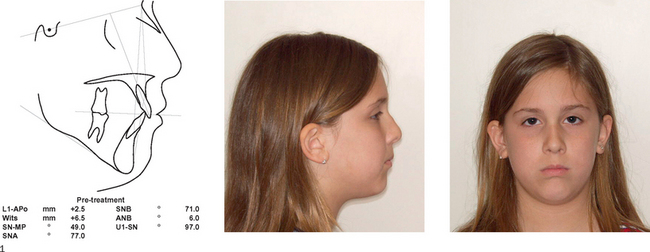CHAPTER 13 Stage II checks
The routine adjustment interval in Stage II is 6 weeks, but can often be extended to 8 weeks. It is not normally necessary to remove the archwires, except at or very near the end of the stage, when offsets and toe-ins will be needed to derotate the first molars.
At each adjustment visit, the following checks will be necessary:
• Observe space closure. This can either be measured direct, or gauged by the amount of excess archwire protruding from the distal of the molar tubes. Where further space remains to be closed, the elastomeric E-Links should be replaced. Obstruction to space closure is rare, but can be caused by premature placement of offsets and toe-ins to the first molars.
• The distal archwire ends. These should be trimmed back to 2 mm of distal projection and turned slightly to the lingual, for the comfort of the patient. If all space has closed in a particular quadrant, the respective distal archwire end should be annealed and turned gingivally, to prevent the space reopening.
• Check molar widths. Normally, these will not require adjustment, unless a crossbite is being corrected. However, as with any appliance, second molars in a first molar extraction case will need particular vigilance as they come forwards.
• Labial segment position and inclination. This may require the addition or removal of brakes, according to whether remaining space closure is required by retraction of the incisors, or by protraction of the molars. Excessive retroclination of upper incisors should be avoided (by placement of brakes on upper canines), as this may encourage apical resorption.
• Attention to centrelines. Except in the case of big midline discrepancies, remedial action will not be required until towards the end of the second stage. At that time, the application of selective brakes should be considered, as described in Chapter 11, usually unilaterally. This may be to induce active centreline correction (see Fig. 11.10) or to defend against an unwanted late shift (see Fig. 11.9) when space remains on one side but not on the other. Failure to obtain coincident midlines by the end of Stage II will inevitably result in an occlusal discrepancy, which will be less easy to correct in Stage III.
• Derotation of first molars. Only relevant at the end of Stage II, this is essential once the space has closed. A 1 mm buccal offset and 10 degrees of lingual toe-in should be added to the archwire at the molar–premolar interspace, as outlined in Chapter 11. Failure to do this will make it difficult or impossible to enter the molar tubes with rectangular archwires at the next visit.
• ‘Un-tip’ the first molars. Of likely relevance to deep bite non-extraction cases, where Begg-derived mechanics have been used during Stage I, anti-tip bends may be required to seat the disto-buccal cusps, as described in Chapter 11. Again, it will be difficult or impossible to feed a rectangular archwire into a distally tipped molar at the Stage III visit.
• Avoid overcompression. At the end of space closure, tight or overlapping contacts should be relieved, by relaxing the gingival cinchbacks at the distal arch ends. Contact point pressure will significantly retard or halt correction of torque and tip in the following stage.
• Check the interarch relationship. Is the patient observing and maintaining their incisor relationship as instructed? Are the intermaxillary elastics being worn sufficiently to maintain Stage I corrections?
Stay updated, free dental videos. Join our Telegram channel

VIDEdental - Online dental courses




